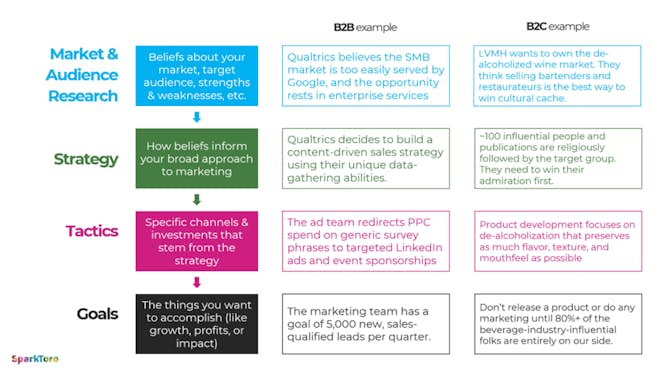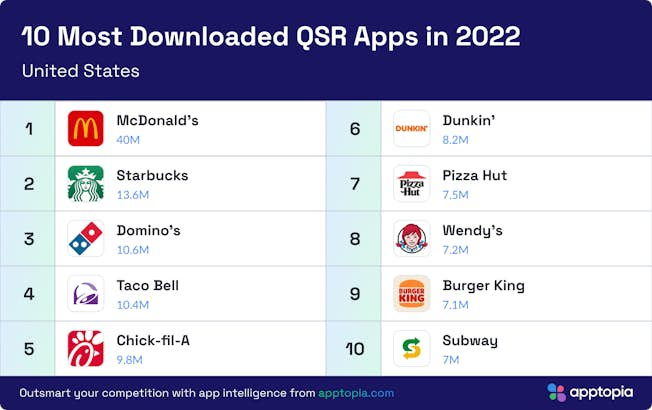Mar 23, 2023
Implementing Digital Strategy: How To Ensure It Doesn’t Fail
Most companies don’t have a problem coming up with digital strategies for all areas of the business (corporate, departmental and functional). Whether these strategies are relevant or not is a discussion for another day.
But what is interesting to explore is why and how these companies fail to implement these strategies. To find out why we’ve made a list of research-based common reasons and barriers to implementing and executing digital strategies.
What’s the difference between digital strategy and tactics?
First, let's look at what a digital strategy is and how it differs from tactics.
A digital strategy is looking at how your internal and external environments inform your marketing activities. It should include elements such as your target audience, existing customers, strengths and weaknesses, and your competitors.
In an ideal world, you should use data to inform and hypothesize. This will help you determine which marketing channels to use or test, your target audience, and how to communicate your message or brand.
On the other hand, tactics are what you use or the actions you take to execute your strategy. This could be testing content across social media channels, a focus on building high-quality backlinks, or trying a PPC campaign on a new audience.
The illustration below from SparkToro gives you an idea of the difference in strategy and tactics for B2C and B2B companies.

15 Ways Your Digital Strategy Can Fail
Now you know what a digital strategy is, let’s look at 15 ways they can fail.
1. Expecting strategy implementation to be easy
Implementing a strategy is often a complex and challenging process that requires careful planning, coordination, and execution. It’s not as simple as coming up with an idea and hoping it will fall into place.
2. Expecting all strategies to be successful when implemented
Not all strategies are successful, and even well-crafted strategies can fail due to a variety of factors, such as changes in the market, internal resistance to change, or the strategy was just not good enough.
3. Expecting that execution should strictly follow a plan
Strategic execution is an ongoing process that requires continuous monitoring, adaptation, and adjustment in order to be effective. The plans are there for a reason, but it is often the case that conditions change and the organization needs an agile approach to accommodate these changes.
4. Thinking that strategy implementation is just about execution
Strategy implementation requires the participation and engagement of all employees, from the front line to the C-Suite. The managers and supervisors who drive implementation should be the ones with the most input due to their natural link to strategy formulators at the top and the actual executors spread out across the organization.
5. Thinking of implementation as a linear process
Strategy implementation is not a linear process, it often contains loops and iterations, and may require multiple rounds of testing and experimentation.
6. Thinking of implementation as operational only
Strategy implementation is not only operational, it also has a strategic and cultural dimension. A change in mindset and culture may be required, especially those mentioned here that act as an obstacle to implementation.
7. Expecting the outcome will be guaranteed as long as the strategy is sound
Even with a solid strategy, it is not guaranteed to be successful and other factors such as the execution and the external environment can affect the outcome.
8. Assuming a shared vision
Without a clear understanding of what the organization hopes to achieve and how it plans to achieve it, it is difficult for employees to make informed decisions about how to proceed. Remember, communicating a strategy does not necessarily mean that it has been understood. Find out how to ‘Be a Communication Powerhouse’ for tips in this area.
9. Equating communication with alignment
Simply communicating a strategy to all stakeholders is not enough. A strategy needs to be aligned across departments, levels, and business units for effective and successful implementation.
10. Automatically putting execution at fault
Some strategies fail because they were never fully formulated. It is often easier to blame the execution of a strategy rather than admit that the strategy was vague or problematic from the start.
11. Ignoring other strategies being implemented in the organization
A strategy being implemented may sit uneasily alongside others being implemented across the organization. This can lead to contradictions, confusion, or employee burnout from dealing with too many initiatives.
12. Fail to monitor progress
When the right metrics are not used to monitor and understand how a strategy is progressing, it leads to errors in implementation. Without understanding progress, it is difficult to identify successes and failures.
13. Ignoring the need for patience in implementation
Those heavily invested in strategy execution tend to want to see results. When results are expected too quickly and do not materialize as planned, it is often the case that people will abandon the execution or make knee-jerk adjustments.
14. Expecting automatic involvement and commitment by all stakeholders
Even when a strategy is well-communicated, understood, and aligned across an organization, some stakeholders might be resistant to the idea behind the strategy or simply resistant to change.
15. Ignoring the knock-on effect of strategies
When organizations implement major strategies, they tend to forget that these strategies might affect normal procedures in the organization. It is often the case that managers and employees get caught up in coping with the changes and ignore the ongoing implementation.
In addition, Candido and Santos (2019) found that it is often the case that barriers to strategy implementation are related. Their work has found that “the evidence gathered from the case study, strongly suggests that the occurrence of an obstacle will probably generate another related impediment, which in turn may generate another and another, leading to a ‘coherent’ chain of obstacles, acting together and reinforcing each other” .
So, we can anticipate that when one of the barriers arises, more are likely to emerge. This can be due to the link between the barriers, or because of management failure.
Case Study - McDonald’s

A great example of a digital strategy causing chaos is the not-so-successful implementation of a new app.
The fast food giant introduced the app as part of a technology update to introduce a new menu and allow delivery and curbside pickup. However, the LA Times reported that its ‘Experience of the Future’ initiative resulted in employees handling more tasks (without pay raises or adequate staffing) resulting in people quitting their jobs.
Plus, it also resulted in customers having to wait longer for their orders - surely not something McDonald’s wanted when bringing in this new technology.
According to one McDonald’s worker, Westley Williams, “It’s more stressful now. When we mess up a little bit because we’re getting used to something new, we get yelled at.”
Since its launch, the McDonald’s app has seen 40 million downloads, way above the competition in the quick-service restaurant category. These downloads have been boosted by offers and celebrity tie ins in its Famous Orders collaborations.

In 2023, McDonald’s move to become more ‘nimble’ will see job cuts in the company and a move to expand and have branches that are both traditional and to-go only sales according to the Wall Street Journal. How staff feels about this move is unclear at the moment.
5 Ways to Successfully Implement a Digital Strategy
Now that you know what not to do, how can you implement a strategy successfully? Let’s look at 5 simple but effective tips.
1. Clarify your strategy
The first step is to clarify your strategy so that people in your organization will understand why it is needed and how it directly involves them. This will help you gain buy-in from all levels in the organization.
2. Communicate it through the organization
Communicating your strategy helps people understand the big picture and ensures successful collaboration. Use internal blogs and message boards, podcasts, and department meetings to communicate what the strategy is and how that strategy informs everybody’s work.
3. Cascade your strategy
If strategy is ‘what’ you do, then tactics are ‘how’ you do it. If you want your strategy to be implemented well, break down tactics into small, practical, and achievable steps.
4. Create achievable goals
This follows on from the above point. Once you have split your strategy into simple steps, communicate those steps and assign them to the relevant people. There should also be space created for people to ask questions and discuss all elements.
5. Use technology
Digital strategies require some technology to drive implementation. Ensure you have the right technologies in place to not only facilitate the strategy and ensure each element can ‘talk to each other’ but also to help staff communicate and brainstorm using online tools.
Wrap-up: Digital Strategy Implementation
Strategy implementation is a complex and challenging process that requires careful planning, coordination, and execution. But as we’ve seen, the biggest barriers to successful implementation and execution are all internal. So, even when planning and coordination are done correctly, management failures and problematic mindsets and cultures will still act as barriers to successful implementation.
But by following these tips, you can increase the chances of successfully implementing any digital strategy and achieve the goals of your organization.
Develop a digital strategy that drives success
As you can see, it’s easy for a digital strategy to fail if it’s not planned, communicated, and fed through the company. Our digital marketing strategy course will not only cover the fundamentals of strategy but explore automation, analytics, budget, digital channels, leadership, and much more. Enroll today to get started!
Related
Upgrade to Power Membership to continue
your access to thousands of articles, toolkits, podcasts, lessons and much much more.
Become a Power Member- Login
- View Courses
- - - -
- Courses
- Resources
- - - -
- My Account
- Change Password
- Logout




